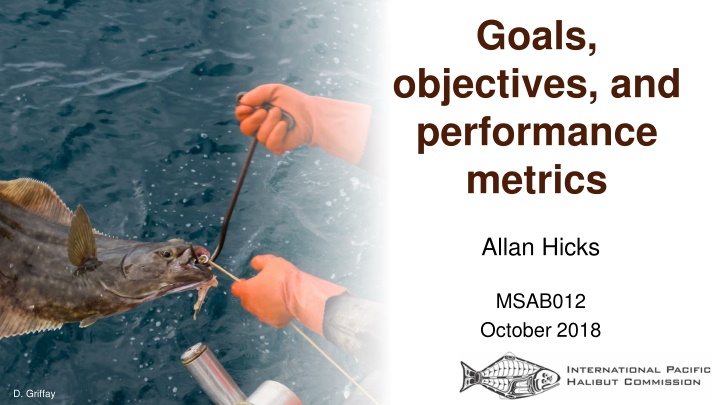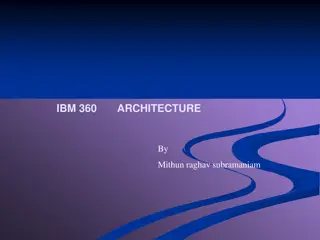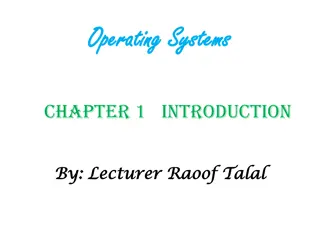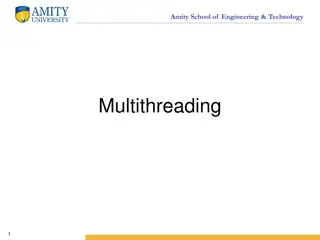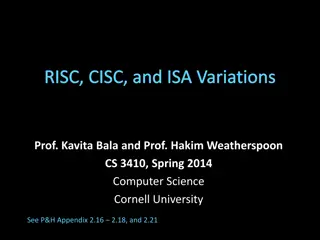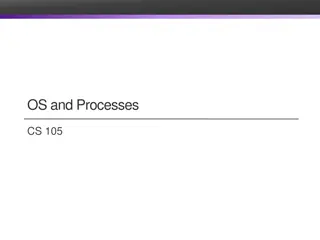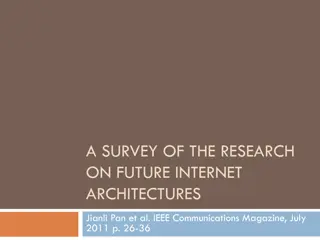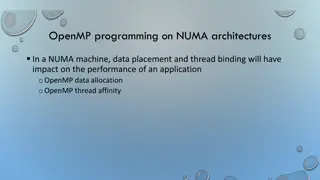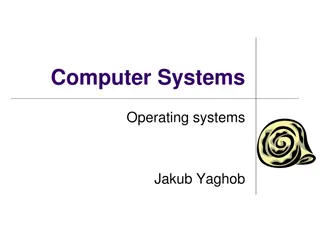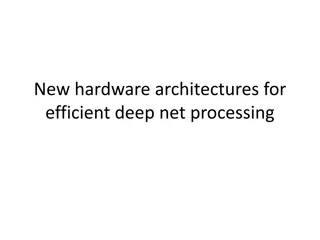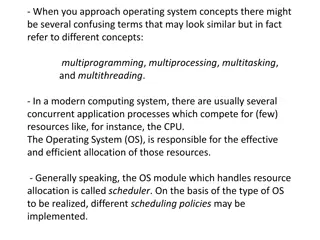Evolution of Multiprocessing Architectures
This content explores the transition from traditional SMP to modern multicore architectures in computer hardware design. It discusses the hardware components, including Northbridge, CPU connections, memory controllers, and the need for synchronization mechanisms in multiprocessor systems. The evolution from shared bus architectures to interconnect-based designs is detailed, highlighting the shift towards multicore CPUs for improved performance and scalability.
Download Presentation

Please find below an Image/Link to download the presentation.
The content on the website is provided AS IS for your information and personal use only. It may not be sold, licensed, or shared on other websites without obtaining consent from the author.If you encounter any issues during the download, it is possible that the publisher has removed the file from their server.
You are allowed to download the files provided on this website for personal or commercial use, subject to the condition that they are used lawfully. All files are the property of their respective owners.
The content on the website is provided AS IS for your information and personal use only. It may not be sold, licensed, or shared on other websites without obtaining consent from the author.
E N D
Presentation Transcript
Goals, objectives, and performance metrics Allan Hicks MSAB012 October 2018 D. Griffay
MSAB-011 Report: Goals and objectives 18 The MSAB REQUESTED that the IPHC Secretariat standardize the terminology for types of objectives 20 The MSAB REQUESTED that the objectives be refined by an Ad-Hoc Working Group 26 The MSAB AGREED that some of the measurable objectives related to Fishery Sustainability, Stability, and Access are redundant and should be considered by the Ad-Hoc Working Group 27 The MSAB NOTED that the following subset of measurable objectives related to Fishery Sustainability, Stability, and Access of the coastwide stock may be sufficient: to maintain a minimum catch; maintain an average catch; provide opportunity for above average catches; and limit annual changes in TAC, coast-wide and/or by IPHC Regulatory Area. MSAB012 Slide 2
MSAB011 Report: objectives 28 The MSAB REQUESTED that the IPHC Secretariat continue to discuss the Biological Sustainability (conservation) objectives with the IPHCs Scientific Review Board (SRB) SRB013_R, para 25 The SRB NOTED that the current IPHC MSE goals and objectives are useful to evaluate harvest strategies using the three primary performance metrics and additional statistics of interest. Further refinements to the fishery related objectives may be made at MSAB012, and reported to the SRB for review. SRB012-R, para 29: The SRB AGREED that the following proposed Biological Sustainability objectives are consistent with standard practice: a) 1.1 is retained with a biomass limit of 20% SB0 and a probability of 10%; b) 1.2 is probably not necessary since the target is a result of applying the harvest control rule; c) Median average relative spawning biomass is also presented; d) and the usefulness of these metrics be re-evaluated once the MSE is operational MSAB012 Slide 3
MSAB011 Report: objectives 29 The MSAB AGREEDthat the goal Serve Consumer Needs is captured under the goal of Fishery Sustainability and Stability, and is not needed. 34 The MSAB AGREED that the Commission should review and provide guidance on the revised goals, objectives, and performance metrics at AM095 37 The MSAB AGREED that objectives should be hierarchical and if Biological Sustainability objectives are not met by a management procedure, additional objectives are not evaluated MSAB012 Slide 4
Goals Biological sustainability Maximize (optimize?) directed fishing opportunities Minimize discard mortality Minimize bycatch and bycatch mortality MSAB012 Slide 5
Ad-hoc objectives working group Peggy Parker, Michelle Culver, Chris Sporer, Dan Falvey Allan Hicks, Steve Keith Met on June 26 via telephone and subsequently over email Identify main objectives Phrase objectives in a useful manner Identify a priority to objectives MSAB012 Slide 6
Objectives (definitions) General Objective: higher level, broad, aspirational Measurable Objective: more specific, can be measured Measurable Outcome: specifically what is to be achieved Time-frame: period want to achieve outcome, number of years to measure the outcome Tolerance: the risk willing to take Performance Metric: the metric determined from the above Statistic of interest: a metric determined that does not have a specific tolerance defined. Typically secondary in evaluation MSAB012 Slide 7
Current Goals and Objectives (primary) GENERAL OBJECTIVE OBJECTIVE Maintain a minimum female spawning stock biomass above a biomass limit reference point at least 90% of the time Limit annual changes in the coastwide TCEY MEASURABLE PERFORMANCE METRIC MEASURABLE OUTCOME TIME-FRAME TOLERANCE 1.1. KEEP BIOMASSABOVE ALIMITTO AVOIDCRITICAL STOCKSIZES SB < Spawning Biomass Limit (SBLim) Long-term 0.10 ?(?? < ?????) SBLim=20% spawning biomass Biomass Limit 2.1 LIMIT CATCH VARIABILITY Average Annual Variability (AAV) > 15% Long-term 0.25 ?(??? > 15%) Maintain TCEY above a minimum level coastwide 2.2 MAXIMIZE DIRECTED FISHING YIELD Coastwide TCEY < TCEYmin Long-term Short-term ?? ?? ?(???? < ???????) MSAB012 Slide 8
Priority Must meet Biological Sustainability (1.1) Then meet catch limit stability (2.1) and maintain a minimum catch limit (2.2) Then, maximize catch limit subject to above Statistics of interest can be informative and benefit the evaluation MSAB012 Slide 9
Biological sustainability Only one conservation objective needs to be met Avoiding stock sizes that may cause irreproducible harm Limit biomass (20% dynamic relative spawning biomass) Target biomass is determined by FSPR (and other parts of MP) Additional conservation objectives could be added Often they are better defined as fishery objectives Maintain a high (target) biomass to keep catch-rate high can be defined as a fishery objective related to catch rates Statistics of interest are also informative The median biomass realized The number of mature females MSAB012 Slide 10
Optimize directed fishing opportunities Optimize may be more consistent with the Convention To develop the stocks of Pacific halibut in the Convention waters to those levels which will permit the optimum yield from the fishery and to maintain the stocks at those levels Stability objectives are listed first but are not meant to have priority over yield objectives. MSAB012 Slide 11
Discard mortality & Bycatch mortality Not discussed by the ad hoc working group Retained for future consideration MSAB012 Slide 12
Statistics of interest Other metrics that are not defined as a specific performance metric with a risk tolerance Median long-term TCEY AAV Probability stock status is less than 30% AAV while on the ramp Probability TCEY is less than 46 Mlbs Range of TCEY (5th and 75th percentiles See document IPHC-2018-MSAB012-06 for Tables MSAB012 Slide 13
Commission Recommendations AM094-R, para 36. The Commission RECOMMENDED that the draft goals, objectives, and performance metrics, as detailed in Appendix IV, IPHC- 2017-MSAB10-R be used for ongoing evaluation in the MSE process, and that they may be refined in the future. The objectives should be evaluated in a hierarchal manner, with conservation as the first priority. noting SRB11 Rec.02 to develop an objectives hierarchy, the MSAB is requested to evaluate management procedure performance against objectives that prioritize long-term conservation over short-/medium-term (e.g., 3-8 years) catch performance. Where helpful in accelerating progress on scale, the MSAB is requested to constrain objectives to (1) maintain biomass above a limit to avoid critical stock sizes, (2) maintain a minimum average catch, and (3) limit catch variability MSAB012 Slide 14
MSAB011 Report: Time-periods 39: The MSAB AGREED to consider long-term metrics related to Biological Sustainability objectives and short- and long-term metrics related to fishery objectives when evaluating management procedures 40: The MSAB REQUESTED that the IPHC Secretariat determine methods to present qualitative results describing the transition from the short-term to the long-term for various performance metrics as a way to describe medium-term performance. 41: The MSAB REQUESTED that the IPHC Secretariat present the methods for producing short-, medium- and long- term results to the SRB for their review and comment MSAB012 Slide 15
SRB Review SRB013-R, para 26: The SRB REQUESTED that the MSAB consider listing prioritized objectives used to guide the selection of a management procedure. These could include any combination of short, medium, and long-term objectives, provided Commission objectives be given highest priority. All performance metrics in the MSE must be computed from the operating model. See paragraph 30 for further clarification. MSAB012 Slide 16
SRB Review SRB013-R, para 30: The SRB RECOMMENDED a clear separation between the current stock assessment process and MSE process, so that it is understood: these two processes, including statistics and performance metrics, are distinct and not comparable; the purpose of the current ensemble stock assessment approach is to develop a decision table to assist the Commission in setting an annual TCEY. This TCEY setting process lacks specificity and how decisions are made is unclear. Furthermore, repeated application of this process is difficult to evaluate relative to Commission objectives; the purpose of the MSE is to compare alternative management procedures against Commission objectives over a wide range of plausible uncertainties within the operating model and management procedures. Therefore, these procedures by definition must be specific and repeatable. MSAB012 Slide 17
Reporting time periods Performance metrics from the MSE are meant to rank the management procedures, not predict The three objectives (conservation risk, stability, maximize catch) are very amenable to ranking MPs Others (e.g., prob TCEY > X) is more of a prediction, but can still be used to rank MPs MSAB012 Slide 18
Appropriate time periods Conservation Long-term is priority Avoid MPs that may result in high short-, medium-term risk or determine a phase-in period Stability Long-term is important Short-term is also important as stock/fishery transition to long-term Yield All time periods are important It somewhat depends on where the stock is now MSAB012 Slide 19
Primary performance metrics Performance metric Description Times out of 100 that the relative spawning biomass (status) is below the limit. The limit is defined as 20% of the spawning biomass if no fishing had occurred. P(SB < SBLim) Times out of 100 that the average annual variability (AAV) is greater than 15%. AAV can be thought of as the average change in the Total Mortality limit from year to year. P(AAV > 15%) Median coastwide TM. The TM is greater than this value in half of the simulations. Median TM MSAB012 Slide 20
Some secondary performance metrics Statistic of interest Description Median SB The median biomass expected in the long-term Median # females The median number of females expected in the long term. The Average Annual Variability, which can be thought of as the average change in the TM from year to year Times out of 100 that the TM decreases by more than 15% compared to the previous year. The average annual variability when the stock status is below the fishery trigger (often referred to as on the ramp ). Times out of 100 that the estimated spawning biomass (status) is less than the fishery trigger, thus invoking the ramp and reducing fishing intensity. Times out of 100 that the Total Mortality limit would be set below a minimum value. The minimum TM has not been determined, and is currently an ad hoc value of 34 Mlbs, which is the minimum Total Mortality observed (TM) since 1906. Times out of 100 that the TMq is less than 54 Mlbs, which is 70% of the average TM from 1993 to 2012. The 5th and 75th percentiles of the Total Mortality limit from the simulations. This means that 5 out of 100 are less than or equal the 5th percentile and 25 out of 100 are greater than or equal to the 75th percentile. AAV P( TM > 15%) AAV|SB<SBTrig ? ?? < ?????? P(TM < TMmin) P(TM < 54) 5th & 75th TM MSAB012 Slide 21
Two types of probabilities P(all ): the probability of that event over all simulations. In other words, what is the probability that this event would occur in a given year. P(any ): the probability of that event occurring in 1 or more years over the defined period Note that this probability increases as the period increases MSAB012 Slide 22
Presentation of performance metrics Control Rule SPR Est Error Autocorrelation 30:20 30% 0.15 0.4 30:20 40% 0.15 0.4 30:20 46% 0.15 0.4 P(all SB < 20%) P(any SB < 20%) P(all AAV > 15%) Primary Median TM Median SB P(all SB < 30%) AAV P(all TM > 15%) P(all TM < 34) 5th & 75th TM Statistics of interest MSAB012 Slide 23
Biological Sustainability Metrics Median average SPR P(all dRSB<20%) P(any dRSB_y<20%) P(all dRSB<25%) Median average dRSB P(any dRSB_y<25%) 5th% average dRSB P(all dRSB<30%) 95th% average dRSB P(any dRSB_y<30%) Median average # mature females P(all dRSB<40%) P(any dRSB_y<40%) P(increase SB|dRSB 20-30%) MSAB012 Slide 24
Fishery Sustainability Metrics P(all Comm=0) P(any Comm=0) P(all Directed < 50.6 Mlbs) P(any Directed < 50.6 Mlbs) P(all decrease TM > 15%) P(any decrease TM > 15%) median AAV TM median AAV Directed median AAV Commercial 5th% AAV TM 95th% AAV TM P(all AAV > 15%) P(all TM < 34 Mlbs) P(any TM < 34 Mlbs) Median average TM Median average Directed Median average Commercial 5th% average TM, Direct, & Commercial 75th% average TM, Direct, & Commercial 95th% average TM, Direct, & Commercial MSAB012 Slide 25
Requests NOTE paper IPHC-2018-MSAB012-06 CONSIDER the refined MSAB goals, measurable objectives and associated performance metrics, and the prioritizing of conservation objectives. CONSIDER the statistics of interest to supplement the evaluation of management procedures. CONSIDER the objectives identified by the US Commissioners at IM093 for distributing the TCEY. RECOMMEND goals and objectives for evaluation of the Scale component of the harvest strategy policy. RECOMMEND a practical set of performance metrics, including statistic of interest, to report for the evaluation of [these and]future simulations[, including time-periods of interest]. SUGGEST methods (e.g. tables and figures) to report the performance metrics listed here for the evaluation of [these and]future results from the simulations. MSAB012 1. 2. 3. 4. 5. 6. 7. Slide 26
What we need for evaluations this week Are there any specific performance metrics that you would like to see this week? What time-periods would you like to see this week? Long-term (final 10 years of simulation) will be reported Others? Let me know what else as we will learn more MSAB012 Slide 27
